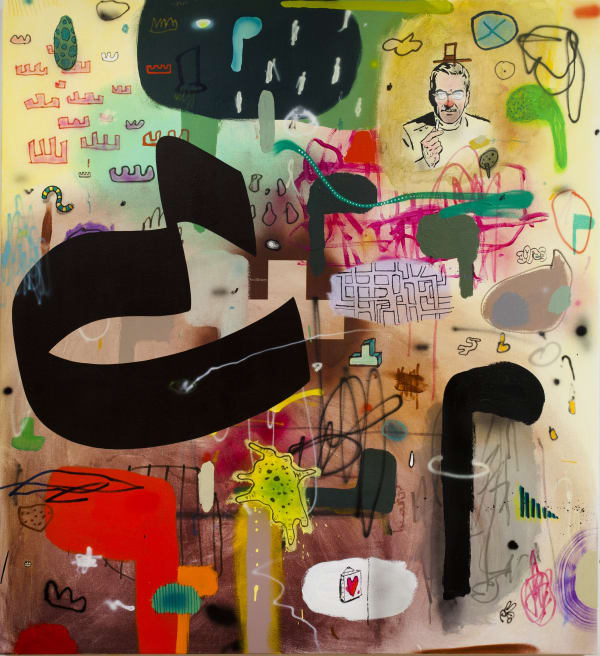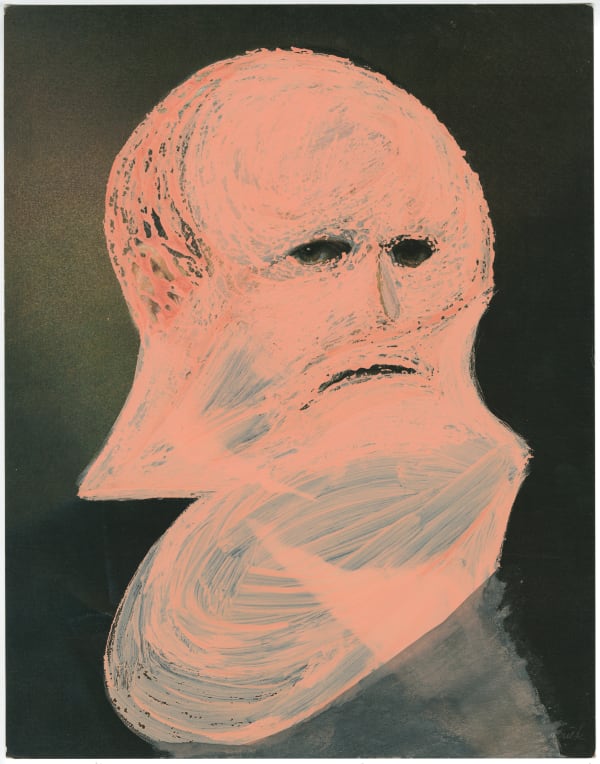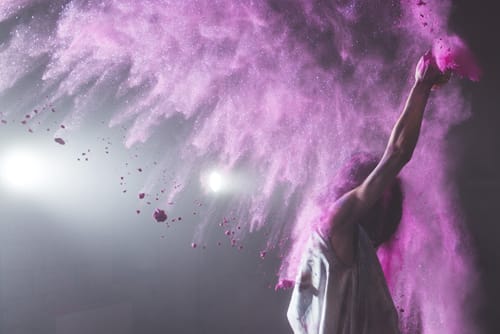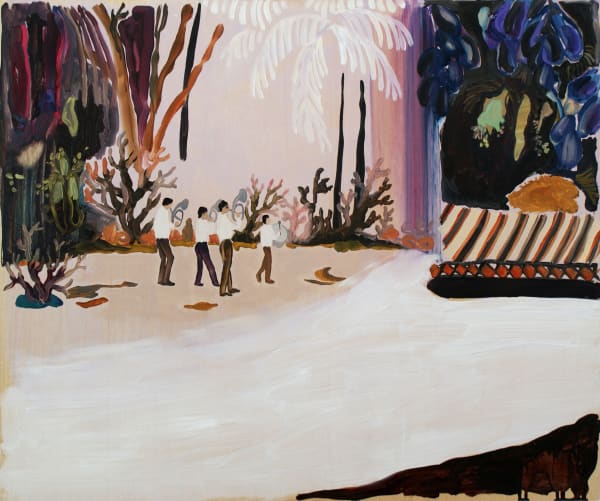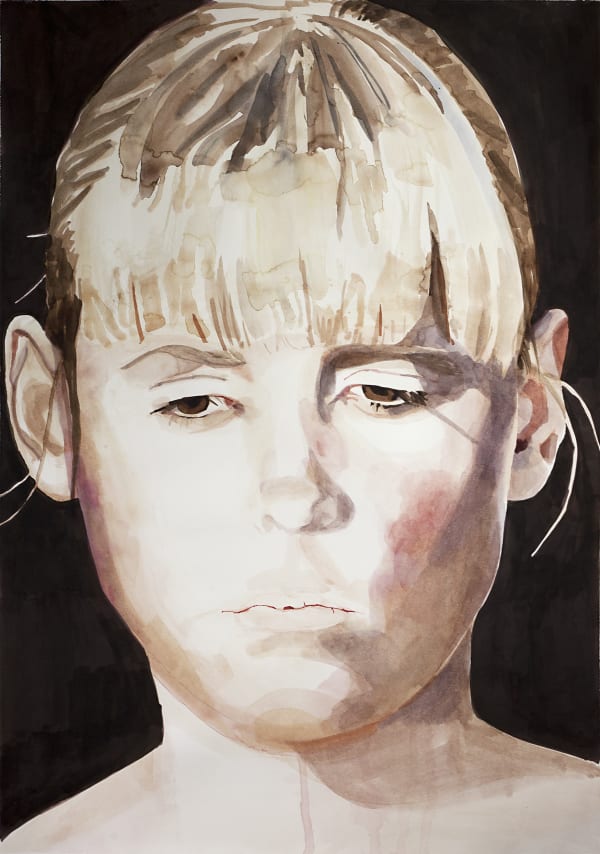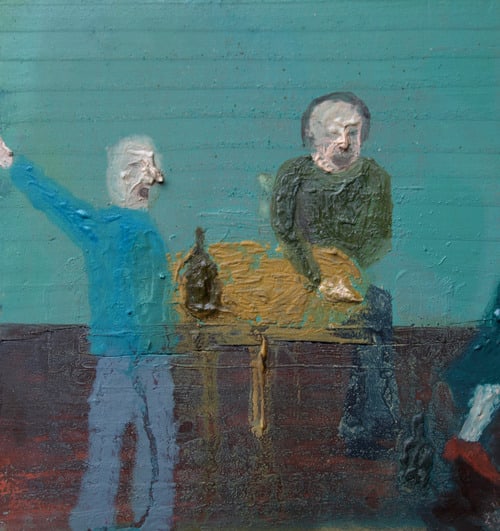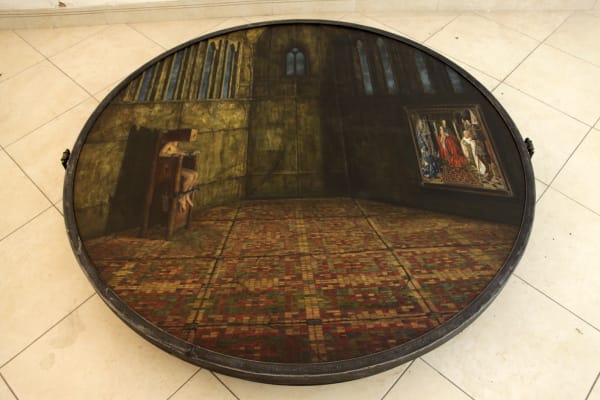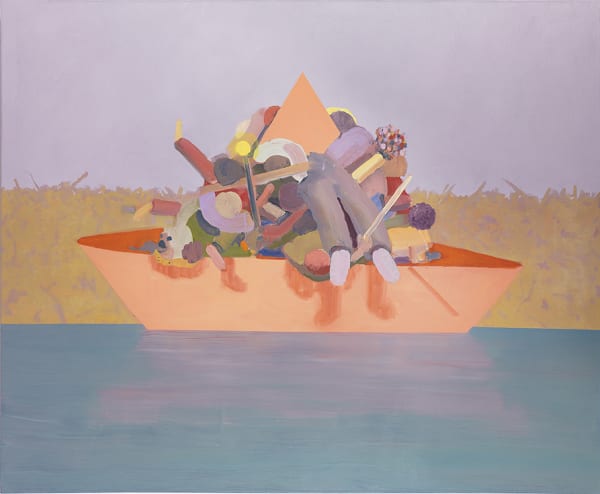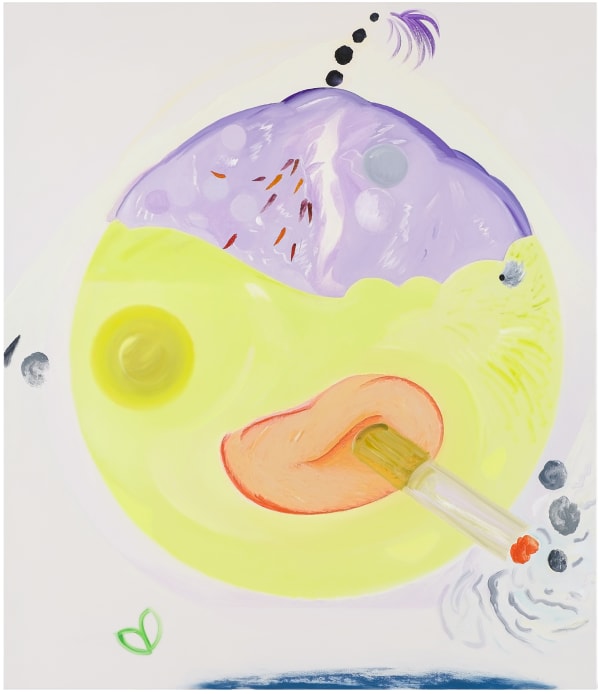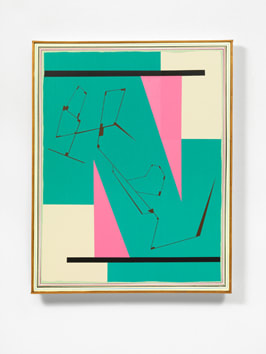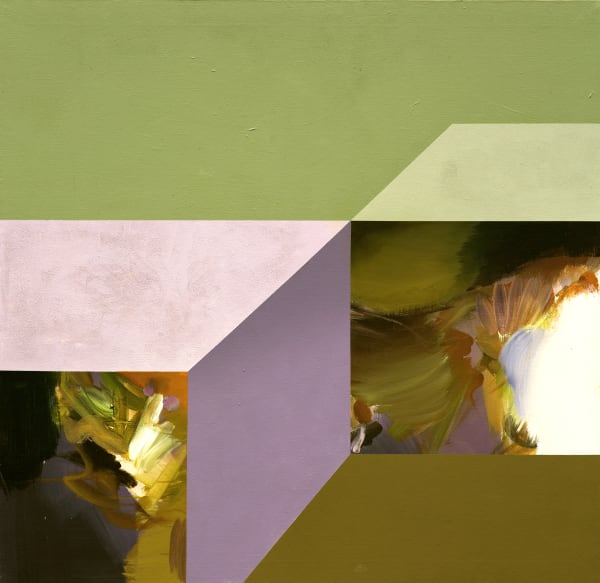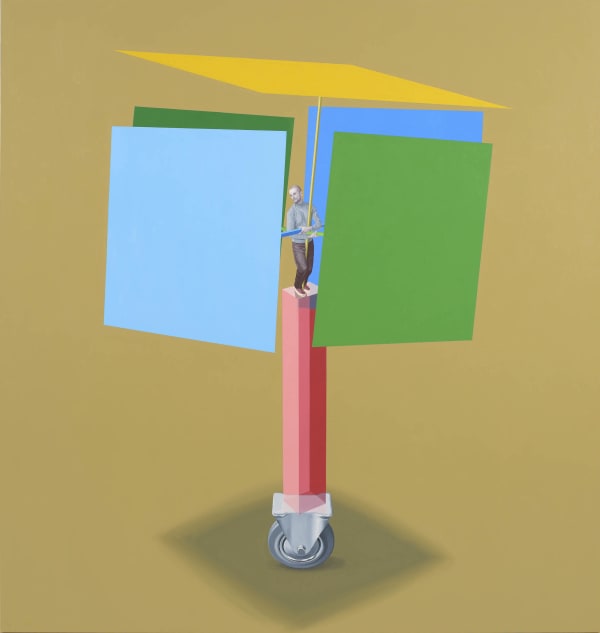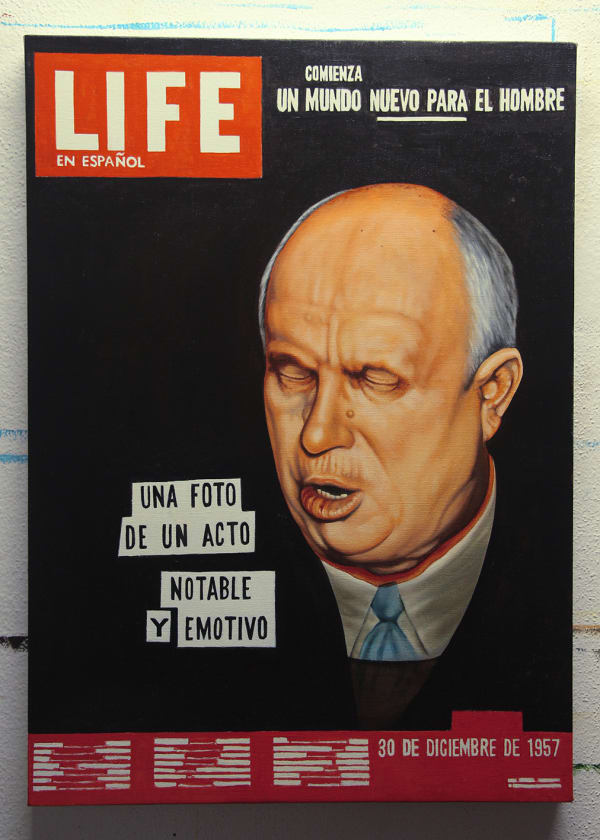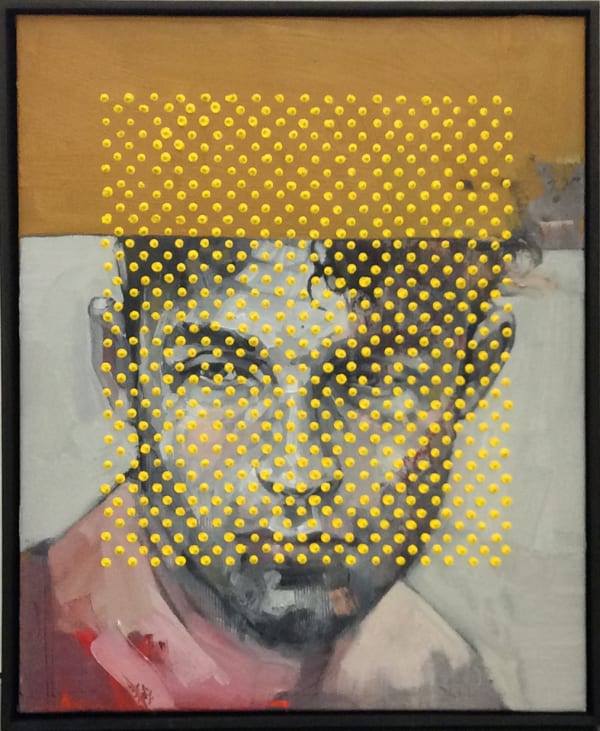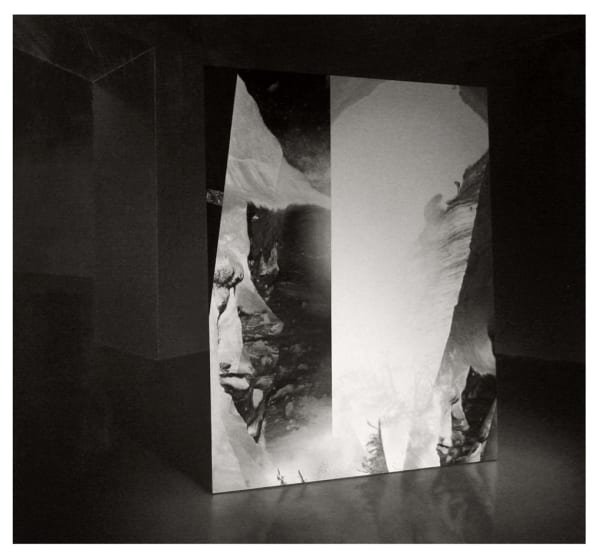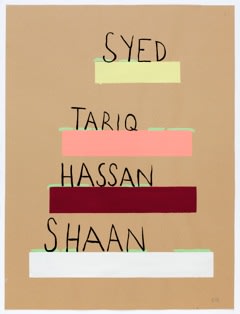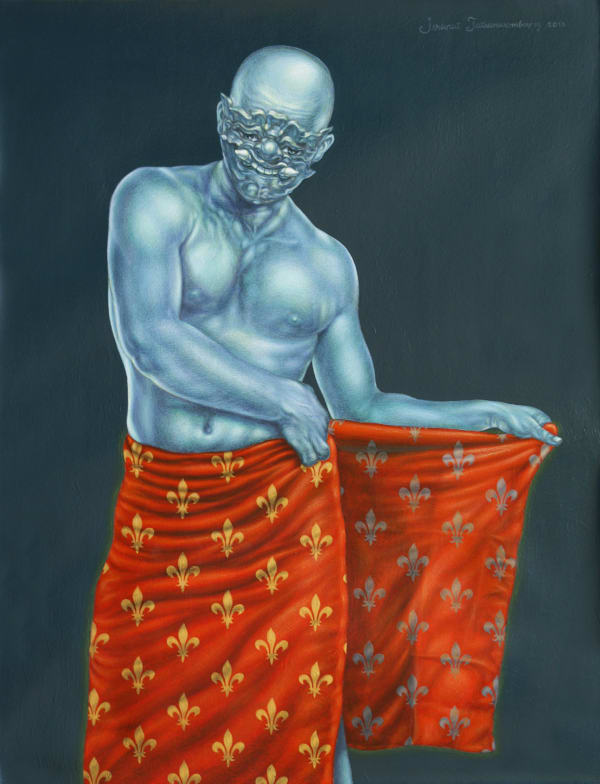100 PAINTERS OF TOMORROW: NEW YORK
HENNY ACLOQUE
British painter Henny Acloque (b. 1979) is drawn to painting due to its ability to transport the viewer to a version of reality that deviates, ever so slightly, from reality. Her small-scale paintings typically feature scenes of a natural idyll, with Classical art-historical references, and references that cull from a personal collection of books, postcards, and catalogues. With a glossy surface texture and often lacquered in resin, Acloque’s work departs from its influences while retaining a firm nod to the works of the Dutch Masters or traditions of Renaissance landscape painting. One of her primary inspirations quotes from the tradition of Victorian Fairy painting, a genre that departs from Romanticism and depicts meticulously detailed scenes in which fairies perform typically benevolent acts, but in Acloque’s retelling these mystical, imaginary creatures (also presented with an assumption of veracity,) are replaced by amorphous painted abstractions that reinterpret and obscure any central figure. By removing or subverting an expectation of ‘the subject’, Acloque heightens our excitement of the work: perhaps it is a perverse act of retention, but as viewers, we seem compelled to the mystery present in the painting’s restraint through her processes, asking us to reconsider the norms of representation. This notion of obscurity is also of critical significance, providing a type of gateway for considering (and re-considering) the Self in relation to the Other as described, or, in this case, obscured).
LESLIE BAUM
American artist Leslie Baum (b. 1971) uses her artwork as a type of diorama or stage in which she invites the viewer to navigate a series of complex yet playfully presented ideas that most often take the form of irregularly shaped canvases adored with painterly abstractions, often perched upright and placed arbitrarily about the exhibition space. For Baum, these multicolored, irregularly shaped and colorful pieces function like contemporary artifacts, in which any multitude of variables “bump against each other in the same context” to generate meaning. By allowing the painting to transcend the confines of its two-dimensional support, the works engage in a negotiation with the viewer through an stage-like tableaux: often, pieces are placed in associative groups about the gallery floor, more telling, she often places smaller objects atop a table, as though to be readily engaged by the viewer. Accentuated by what she refers to as ‘imperfection of her hand’, Baum’s on-going series Particular Histories is likened to the children’s game, Telephone, where “distortion and misquotation yields fresh imagery”. Such an analogy seems appropriate for work that urges us engage with an almost childlike sense of discovery, where painted elements serve as both complete objects and building blocks for a larger narrative. In fact, through her own creative process of discovery, Baum’s installations ask the viewer to consider how we experience our surrounding environments on a larger context. Taken as a whole, the works challenge the modern canon as much as they pay it homage. “A good painting can collapse time, evoking the past, present, and future. For me the act of painting is the act of wondering and wandering.”
NINA BOVASSO
The Utopian idealism and pop sensibility of the 1960’s are a major influence in the dynamic paintings of American artist Nina Bovasso (b. 1965). Drawing inspiration from retro textile designs, she re-contextualizes patterns and shapes and in lieu of hard-edged geometry or crisp patterning, she prefers to embraces a handcrafted aesthetic, almost artisanal or childlike in appearance, where each shape is dependent on the last until her paintings seem to heave with organic masses, tentacles, rays and repeated intuitive patterning. Allowing such wild and gestural marks to exist with such presence emphasizes the humanity behind them; in some instances, pieces larger than the artist herself ask us to make a connection to the bodily, the psychology of the artist and work, and the sheer exuberance that seems to burst from the canvas. More recent works see Bovasso pursuing her interest in the surface materiality of the paintings, almost as a reactionary measure to the increasing presence of digital mediums in the art world, where scarce a hand gesture or organic technique is found. For Bovasso, even her works featuring pixellation or geometry warmly embrace their human origins and wonky execution with a gleeful presentation. It is unsurprising that Bovasso is fascinated by our sense of interaction with her paintings, asking a contemporary audience to re-evaluate our relationship to communicative symbols and patterns that transcend the coldly distance of the computer screen and engage with their full physical presence, sense of imagination and fantasy.
DAN BRAULT
Through a playful, multi-layered, and intuitive approach to media, Dan Brault (b. 1979) attempts to provide his viewers with an experience of painting as discovery. A Quebecois artist and 2006 Masters graduate of Laval University, Brault considers painting the ultimate form of virtual reality. His spirited creations utilize image fragments and elements of design to entice and intrigue the viewer. Drawing inspiration from nature, personal experiences of joy and grief, and an arbitrary relationship to colour, shape, and freedom of form, Brault believes that “nature is ultimately the best computer: our minds and our hands will always be the richest tools to use when it comes to image making.” His loyalty to the medium of painting is evident, and he sees it as a critical means of constructing new visions and realities. For Brault this vision prioritizes colour, optimism, and positivity over any such conceptual approach. His laissez-faire attitude seems to penetrate through the works, and his laidback approach is evident in any one of his compositions that prioritizes shape, form, and colour. Not unlike Kandinsky, whose work was meant to inspire with the joy of music, Brault’s intention is to make interaction with his works an exciting and memorable experience. The artist quotes Matisse, Basquiat, Hockney, Stella, and contemporary artist Tal R as major influences. His relationship to painting is one of joy and identity, and the visceral materiality of paint informs his working method. For Brault, it is more than a medium—it is an extension of self and a means of articulating urgent thoughts and feelings.
BENJAMIN BRETT
In a painting titled Floorswamp, 2013 Royal College of Art (MFA) graduate Benjamin Brett (b. 1982) has liberally applied a vibrant blue wash to the surface of a pre-existing painting. One can still see the traces of a figure underneath, floating hesitantly near the surface of the canvas. Other marks (or what the artist refers to as “stains”) also exist under a so-called ‘swamp’ of colour, as though the artist turned the canvas 90 degrees and continued painting. A similar treatment has occurred in Untitled (Dancer), where a rhombus motif has covered a penultimate painting that appears to exist underneath the final treatment. In American-Type Painting theorist Clement Greenberg considers the latter-year apple paintings of Cezanne (b. 1839-1906) as an attempt to conveying the sheer essence of the subject matter, and not as a painted recreation of the object itself. “To transcribe something looks for a direct likeness whereas to translate something seeks a different perspective,” the artist states, “In older works I would choose specific objects or photographs to paint from, the key factor in the selection of these subjects was that their visual appearance was ambiguous or could be interpreted in numerous ways. Through the manipulation of these images in paint, I would use these subjects to inform or explore conventional aspects of abstraction.” Brett’s works inhabit a similar pursuit, where the act of suggesting rather than revealing objects seems to prevail. In this way the paintings transform into subtle traces of reality. While Brett’s works enunciate quite little in terms of concrete subject matter, the artist always retains an underlying desire to convey a narrative. It is through a kind of semiological connect-the-dots that these undercurrents of narrative inevitably emerge. “In other words this is to say something isn’t entirely abstract, it comes from something…their starting place is still in representation, so yes, they are about the essence and to use the article/object in order to translate it into something else.
ANDREW BRISCHLER
“I’ve never thought of painting in relation to or in opposition to our digital age,” claims Brooklyn artist Andrew Brischler (b. 1987). “Painting, the primal urge to record an idea visually, is an inescapably universal phenomenon.” Brischler pinpoints the moment of interest as something more contextual, operating beyond a penchant for hard-edged geometry, angular ‘doodles’, or brightly colored gradients. However, despite loud, assertive tendencies, he finds himself most interested in the moment when an expertly crafted painting begins to fall apart. These moments of revelation for Brischler are abundant, canonical and inevitable: “You see it in the puckered corners of Warhol’s massive diamond dust paintings; in the black stains of Al Held’s colour fields; and in the tremulous lines of Frank Stella’s early shaped works. Tiny failures that make even the most monumental and heroic paintings seem flimsy, vulnerable, even sad.” As such, Brischler’s works have less to do with pure geometric abstraction and have more to do with locating ones’ place in time and space. “I am unavoidably, shamelessly, a ‘millenial’ ” he states, but Brischler’s paintings both embrace and depart from notions of superficiality in order to speak to his own feelings of self-consciousness and mortality, a process that weaves his own anxiety into otherwise bold and paintings that seem a conceptual hybrid between the techniques of Op Art and the suggestion of the memento mori. At one point, it is possible to imagine these pieces as time capsules from the Pop Art Movement, their frayed corners and sandy backgrounds almost serving as a nostalgic reminder of some long forgotten, much cherished Golden Age.
JORGE CASTELLANOS
One speaks of the death of art, the death of painting, the death of modernism. Modern art has become obsolete, corpses, a story long forgotten, archeological ruins of an incomprehensible past for a new art. If modern art is dead, one must show it dead in order to vindicate it as art, and value its formal possibilities, showing it terrible and eliminating its decorative connotations.” In the paintings of Mexican artist Jorge Castellanos (b. 1982), vividly rendered flesh tones, mangled bodies, and graphically disfigured forms combine to evoke the presence of death, reminiscent of death masks, or even death ritual, but always to an intensely unnerving result. Castellanos’s vision of Mexico pertains to a greater societal and cultural whole; appropriating from a long history of Mexican painting that has a preoccupation with death, beginning with the religious Retrato, which features visitations of saints to the recently deceased, to the macabre tendencies of Orozco, Kahlo, and Siquieros. The work also serves as a greater commentary on the alleged “death” of painting, exploring the function of the medium within the contemporary world. “My work emerges from the vestiges of modern art in a new context, within the present reality of contemporary Mexico, the violence of form: the remains of human carnage mingled with the remains of modern art”. Appropriate, then, to allow form to equate content: with titles like Head Trophy and Modern Dorian Gray, Castellanos pays tribute to the cultural and artistic tradition from which he derives but also allows his multifaceted inquiry to generate a new entry point and critique on the status of contemporary art.
CHOKRA TOMORY DODGE
For an artist, there is often great visual potential to be found in accidents and mistakes. Los Angeles based painter Tomory Dodge (b. 1974) approaches her canvases with an open mind and is captivated by the landscapes of the Californian desert and the American West. Her work, which she considers is positioned somewhere between the abstract and the representational, attempts to derail the traditional trajectory of representation. In Washington State, for instance, the presence of an impasto wash in the vein of Gerhard Richter atop a forest green underpainting seems to suggest a nature painting of pine trees under a crisp morning sky, its title further emphasizing this dichotomy between representation and abstraction. Aside from conceptual considerations, her paintings evoke a fascination with the materiality of paint, and what she calls a “central mystery” inherent in the medium. The experience of painting itself is a primary concern for Dodge; she considers it to be a basic human instinct, yet recognizes that it is currently obsolete for many purposes other than artistic creation. Although Dodge continues to push the boundaries of her artwork primarily through painting, she finds herself most interest in the notion of a creation for its own sake, where her attempt lies in the pursuit of translating experience into other forms of visual communication.
FREYA DOUGLAS-MORRIS
Freya Douglas-Morris (b. 1980) uses her paintings to expound on her fascination with place and experience. With loosely conjoined landscape elements forming an imagined reality, her paintings offer a unique opportunity for engagement with the viewer. Their ambiguous and often imprecise components elicit curiosity, along with a strange sense of familiarity. Although they reference both landscape and narrative, the scenarios she constructs are not specific to a real environment. Douglas-Morris is driven to occupy the threshold between reality and fiction, familiarity and foreignness. She approaches her paintings with a desire for dislocation from narrative space, and the excitement of a journey through time. These are paintings that depict the experience of being somewhere, rather than a literal translation of any one particular place. For Douglas-Morris, painting is the ideal medium for such an excursion. It allows her to experiment with temporality and metamorphosis, imbuing each of her works with a rich history and lineage, however subjective this journey might be, it is her desire to present us with its strange, dreamlike details.
TIM ELLIS
Tim Ellis’ (b. 1981) series entitled United in Different Guises features a number of paintings, vaguely reminiscent of militaristic banners or flags, that have been folded, scuffed, gradually aged, and hung by bulldog clips, as though textiles recovered from ancient or forgotten republics. The source imagery used is a mixture of signage and design that has been reconstructed to form gendered symbols, gleaning in equal amounts from Japanese symbolism such as the Ensō, and Art Nouveau. With nods to contemporary artists like Gert & Uwe Tobias, and even finding suggestions to (perhaps less visceral) origins in Viennese Actionist performances by artists such as Hermann Nitsch, these works are loaded with cultural and historic significance. What remains is a series of symbols and messages that question notions of symbolism and authenticity. In fact, Ellis’ syntax is sourced from daily life, art history, and his surroundings in contemporary London, creating what amounts to a subversion of historical referencing or a codified language system that appears to defy chronological or cultural classification.
MATILDA ENEGREN
The evocative portraiture of Finnish painter Matilda Enegren (b. 1989) is an inquiry into the nature of human communication. Working from a photographic base, Enegren uses painting to lend longevity to the otherwise fleeting moments encountered in everyday life, commenting on the gaze, ideas of recognition, and our recognition with the depicted subject. She is inspired by a love of the subtleties of illumination, and carefully renders her subjects in varying nuanced lighting scenarios. The act of partially or completely obscuring the faces of her subjects is a means through which Enegren questions the complexity of human relationships. It also alludes to another critical interest of the artist: the reality of vision and perception. Through a body of work entitled Gaze, Energen references Lacanian psychoanalytical theories such as one’s relationship to the Other, symbolism, and even desire, which, according to Lacan, “is not a question of recognizing something…In naming it, the subject creates, brings forth, a new presence in the world.” So it seems Energren is concerned with this very scopophilia, or politics of looking, where the overriding cultural implications of looking at art, which, in a sense, looks right back at you. Enegren asks the viewer to consider his or her own role as an onlooker, where the use of paint reminds us that it is a fallacy, a construction, that is both outside of and connected to reality.
MICHAEL FANTA
Reflexivity is a challenging concept to successfully achieve within contemporary painting. All too often it seems like an afterthought, superficially imposed upon the art after its creation, or too forcibly entwined in the fabric of its make-up that the painting itself seems to suffer from this conceptual baggage. The paintings of Austrian artist Michael Fanta (b. 1989) articulate a certain autobiographical detachedness that seems to fall back upon itself, rather incidentally. “Working in painting, one thing seems to be very present: how the actual paint and the way surrounding objects present themselves in ones own personal view, can meet at certain points.” One series of works features a recurrent skull that the artist has placed to look back at the viewer, perhaps as a tongue-in-cheek variation on the memento mori. “Painting has become some kind of arena for the subconscious…” His paintings, typically titled after the dates they were completed, commonly utilize a mise-en-abyme effect in which paintings appear within paintings, the skull moving comically, eerily throughout the various compositions. Learning from his teacher Daniel Richter, Fanta’s work is intuitive and causal: “I am not very analytical, but if a painting is good, it should be able to explain itself.” So one is left perplexed as to whether a series of works entitled The Drunk Paintings, ostensibly featuring drunk or drinking men in various stages of inebriation, are titled as such simply due to their subject matter, or whether Fanta is playing with semantics and performance, painting the works while he himself is drunk. He asserts that within his practice “every object can be used as a tool to tell a story.”
ROBERT FRY
In his painting entitled Man with Vesalius Skeleton, British artist Robert Fry (b. 1980) pays homage to Dutch anatomist Andreas Vesalius, a 15th century author of one of the most revered anatomical books ever written. The painting is executed in what has become Fry’s trademark style: a flattened perspective in which a human figure is reduced to its bare elements, with scarce an outline to denote a male figure facing an almost indiscernible skeletal entity. Fry is only concerned with mapping the body in a referential sense, where figures are stripped of any sense of naturalism or anatomical concern. His paintings engage a series of codes and systems that have become trademark to his telling style: figures stand as though lifted from Egyptian hieroglyphs are bathed in any number of mixed media approaches, including resin, oil-pastel, marker and paint. His compositions are typically framed within the painting by a thin contour line that traces the outline of the canvas itself, and the paintings themselves are generally bathed in deep magentas, purples, and violets, colors that, while typically ungendered, are linked to piety and royalty, and have appeared predominately throughout Fry’s practice since 2010. In this way, Fry references the act of obscuring information and identities to give way to psychological insinuations, where figures are obscured by Rorschaech-style inkblots or even three-dimensional Rubix cubes, allowing Fry to build tension in his work through the application of layers and textural qualities to the surface of the canvas. These elements serve to a greater conceptual mythology in that these altered the physical identities suggest a complexity of meaning beyond what is immediately evident. His preoccupation to find a new language of representation through metaphysical concepts of representation, using a the language of abstraction and expressionism. “I create a relationship between the physicality of materials and psychological terms,” he states “and I am interested in conveying a slightly brutal picture of the human condition.”
KATE GOTTGENS
Drawing from a pool of found photographs and images from her own family albums, South African painter Kate Gottgens (b. 1965) removes the familiar photographic representation from nostalgia and translates it into an unstable context, where figures and details remain purposefully ambiguous. Undulating between withholding and revealing, her paintings offer only momentary glimpses of clarity, where interiors and figures seem to drift in through a haze of memory. Typified by a certain distrust of reality, and filtered through the subjectivity of painter as omniscient storyteller, the paintings omit and avoid many descriptive features to allow her to focus on the implications of the image, manipulating the fine line that exists between reality and fiction. We assume that she incorporates her own social history and personal narrative into her work, but equally telling is her attention to skewing the colour palette to evoke certain emotions, a certain vernacular imbued by faded photographs, the saccharine feeling of a Technicolor film, or a vintage advert. Suburban scenes, empty interiors, and everyday landscapes ask us to reconsider elements of nostalgia with a slightly ominous atmosphere, as though these nostalgic recollections are tinged with elements of pain, regret, and even dread when reconsidering the past.
SHAHRYAN HATAMI
Born in 1983 and working from Tehran, artist Shahryan Hatami approaches painting with the curiosity and intellection of one who is enthralled by thoughts, fantasy, literature, art history, and even dream. We are able to project images of Arabian Nights as we are the Tower of Babel, or even cues from the Neo Classicist period. A particular painting seems to feature a floating world, ostensibly lifted from the musings of Borges. In another untitled image, Hatami transforms the plane of the painting into a desolated marshland, littered with the debris of a lost civilization. An owl looms overhead while a pair of infants clutch each other, Pieta-like, amidst the remnants of the past. In another, a figure in a leopard costume mounts a lion, a cobalt-hued peacock barely visible in the corner, yet the setting seems totally familiar, even uncanny. It recalls Antoine-Jean Gros’ Bonaparte Visiting the Plague Stricken in Jaffa (1804), or even the sepia color scheme and macabre Romanticism of the work of Gericault. However these are undoubtedly informed by Hatami’s Tehranian background, for there is a tendency toward history painting, however magic realist. Here, a theme of self-inflicted destruction is central to the paintings, and Hatami demonstrates a consistent desire to visually explore a hypothetical demolition of humankind, perhaps commenting on the historical and fantastical realms from which they are drawn. The paintings transcend mere representation, adopting a visual language through which we may discuss deep-seated psychological fears. Furthermore, these works evoke the mystique of painting itself: the artist’s passion for the materiality of paint is evident, yet balanced with a belief that the true function of art lies in its emotional journey. For Hatami, the process of creation is one which is intricately tied to an internal journey of self-examination, critique, and, ultimately, fulfillment.
HANNAH HEWITSON
For Hannah Hewiston (b. 1977), painting is about the tangible, evident reactions that occur upon the canvas in and of itself. She avoids concept, subject matter, and theme, in favour of the purely technical aspects: the tactility of paint, the visual message, and the responsive qualities of her own subjective process while working. “I navigate a painting through the heat of the artist’s hand,” she states, working through each painting as though it were a series of problems seeking resolution as they present themselves. Often, she paints over existing paintings to create new layers of meaning. In paintings like Constructor or Platform, these ghostly traces suggest paintings that existed in previous incarnations before Hewiston resolves them. The insinuation of this approach where painting acts as palimpsest dislodges the work from mere design or composition, to suggest a further, deeper reading, or even a bit of their own process-driven creation, wherein Hewiston articulates and rearticulates an intuitive vision. With little planning, Hewiston’s process owes its playful, organic spontaneity to causality and chance, in which each gesture informs the next, and each painting leads to its successor. “Painting embraces failure,” she states, “It is an investigation into the relevance and possibility of the painted mark through both an engagement with it and detachment from it. I am interested in how the painted gesture has the power to ignite imagination.”
ALON KEDEM
“What stories do we tell ourselves? How do we perceive reality?” Alon Kedem (b. 1982) believes these inquiries to be critical to the act of painting. A graduate of Jerusalem’s Bezalel Academy of Art, Kedem’s paintings are intended as platforms open to interpretation. To use his terminology, they are neither “open nor closed,” “inside nor outside.” For Kedem, the works are defined by explication as much as they are by suggestion, allowing the viewer to read reality through their own so-called “veil of unconscious subjectivity”. Through a system of signs articulated in paint, Kedem is concerned with how we perceive and understand language via the visual, semi logical systems that typically surround us in daily life. The paintings are active, suggesting movement and featuring scenes in transition, where at times the difference between subject matter and sheer mistake becomes indecipherable. In one instance, a painterly mass appears to be a depiction of a rubbish heap; in another, this same pile appears more corporeal, almost like a pyre of detached limbs. The artist credits Philip Guston as a primary influence, and a linkage is made where Kedem quotes Guston’s penchant for codifying personal symbols and indecipherable objects. Despite their cartoonish renderings, we sense a deeper subjective complexity and point of view. One particular painting aptly articulates Kedem’s wry, almost macabre perspective. In it, a box sits atop a conveyor belt, but upon further inspection one may notice a human limb, all tempered by his preferred palette of pastels: A painterly scene navigating through horror, humour, nostalgia, and play.
JENNY KEMP
The human body represents a vast world of unseen interactions. Jenny Kemp (b. 1979), a New York based artist, is intrigued by that which is hidden and unseen. Biologically inspired, her paintings act as meditations on a human relationship with the organic world. Patterns made through delicately crafted lines flow through the surface of the paintings, suggesting a constant state of physical and emotional development, growth, and movement. She draws from a keen interest in scientific interactions, but tempers these fact-based sources with an artistic perspective. The passing of time also influences Kemp’s practice, and she views painting as an inherently temporal medium, with each brushstroke serving as a record of a specific moment in history. In this regard, the idea of ‘painting as a record’ informs her perspective and her process, and Kemp always bears in mind the materiality of her work, drawing attention to this through freely abstract compositions. Titles like Decodelia and Conchodial reference both personal memory and imagination, as well as naturally occurring systems, respectfully. In some ways, the materiality of paint serves as a metaphor for the cycle of our physical and organic relationships through the course of our lives as humans, and Kemp’s process appears to reference this.
TAMARA K.E.
The work of German artist Tamara K.E. (b. 1976) may first appear to be whimsical, even simple, colorful sketches with various references to both early 20th century illustrations executed with the gestural quality of a scribble. However, further consideration reveals each painting to be anarchic, unfolding, and dynamic. Perhaps their scale is telling; with most pieces measuring approximately 2.5 meters in height and two-meters wide, they belie their own coquettish nature. K.E. herself negates any conceptual meaning, stating that the works are bereft of the political, social, or linguistic, but rather, a desirous exploration of consciousness. In both treatment and scale they recall the work of Twombly, or perhaps reduced re-imaginings of Kandinsky, or Sonia and Robert Delauney, even reminding us of the same graphic quality inherent in Andy Warhol’s early illustrative drawings. K.E. describes it as a process of turning colours, events, or signifiers into a “substance of seduction”, where she, as artist, is a nomad wandering through these dreamlike terrains.
FRANK MAIER
Perhaps it seems that abstraction and realism are opposing genres that cannot be reconciled—but the paintings of German artist Frank Maier (b. 1966) beg to differ. Maier considers abstraction to be merely an extension of reality. His paintings are reflections on real life experiences, and in some regards he views painting itself as a manifestation of authenticity. This may seem like a paradox given the stark, design-like paintings that Maier produces, but for him the works speak to a narrative, almost like a constellation that traces memory and emotion. Through each work he establishes a set of modes that seek to alter the way we as viewers consider and understand symbols. The elements of line and geometry on Maier’s canvases provoke a discourse on the significance that these symbols hold in our lives, both in a literal and metaphoric manner. For Maier, painting is the only way to explore such profound concepts, where the physicality and materiality of paint becomes an allegor


